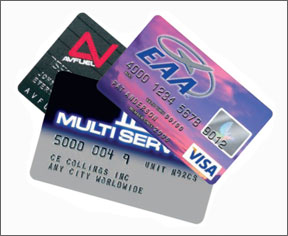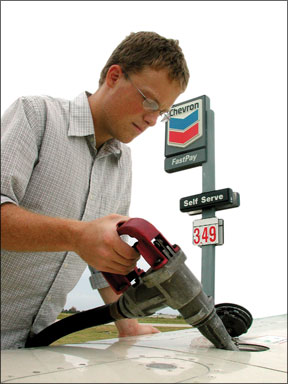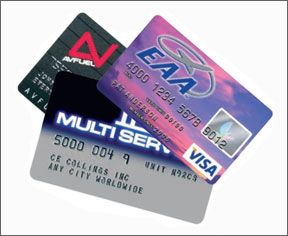Buying

Seneca made an emergency landing onto a busy section of the autobahn after running the tanks dry, injuring seven people. According to investigators, the pilot forgot his credit card and didnt have enough cash to buy fuel for the trip. Officials said he scraped together almost enough cash to buy the minimum fuel to complete the flight. He almost made it the airplane crashed just short of Essen-Muelheim Airport, the intended destination.
On the flip side, two pilots flying from California to Texas in December aroused suspicion when they tried to pay cash for fuel during a stop at Albuquerques Double Eagle Airport, prompting a search of the airplane. While police did find 160 pounds of marijuana in the rented airplane, it can be reasonably presumed that anyone trying to pay cash for avgas or Jet-A could arouse suspicion (especially after 9/11) and trigger a time-consuming and embarrassing search of the aircraft. So the question is not whether you’ll be using a credit card to buy aviation fuel, but which card you’ll use. And here, there’s much choice: branded aviation fuel cards, non-branded aviation fuel cards, co-branded major credit cards or just the plain old vanilla major credit cards.
With the economy humming along, Americans have been on a buying binge, mostly financed by charge cards. According to consumer credit groups, the average U.S. household credit card debt is more than $11,000, a number that has steadily increased over the past number of years. According to the Government Accountability Office (GAO), credit cards usage is widespread, with some 1.5 billion in circulation in the U.S. thats five for every U.S. citizen. In total, Americans used some 700 million credit cards to purchase more than $1.8 trillion in goods and services in 2005 alone.
Most cards are backed by six major issuers: Citibank, Chase Bank USA, Bank of America, MBNA America Bank, Capital One Bank and Discover Financial Services. Ever on the hunt for new customers, the banks have developed deals with businesses and non-profit associations to issue co-branded credit cards.

And here, there are several co-branded aviation credit cards. Its no secret that both the issuing bank and the associated company or organization are in it for the money. The Experimental Aircraft Association has a card, as does the Aircraft Owners and Pilots Association. Even some aviation businesses have co-branded major credit cards: McGraw-Hills Aviation Week magazine offers its own VISA card, and aviation fuel supplier Air BP issues VISA cards in conjunction with Chase Bank.
These co-branded cards act just like any other major credit cards bills come monthly with an option to pay in full or with a small minimum payment. Interest rates can vary anywhere from 8 percent to 30 percent, depending on the bank issuer and the card owners personal credit rating. The users credit limit will regularly be increased as long as payments are made on time.
But using plastic exposes users to all manner of hidden charges, from annual fees to late charges to over-limit penalties. From 1996 to 2003, the GAO said banks revenues from fees have more than quadrupled to $7.7 billion and Americans now spend about $90 billion annually on interest and penalty payments on credit cards. Caveat emptor read the fine print on the credit card application before applying.
However, the GAO recently warned that fee disclosures are difficult to understand and they might not mention or might hide important information like when cardholders would be assessed late fees and what actions could cause issuers to apply interest rate penalties. If youre not sure, call the issuer and ask questions.
While the major credit cards can be used by small and large airplane owners and operators alike, some aviation fuel cards are targeted for use by professional pilots. For example, ChevronTexaco Aviations Alliance credit card is issued only to corporate flight departments; small aircraft owners need not apply. While the Exxon AirWorld card doesnt exclude owners of small airplanes, users need to buy more than 500 gallons per billing cycle (between 28 and 35 days) to qualify for fuel discounts.
For branded aviation fuel cards, payment is expected at the end of the month and those who carry balances end up paying an 18-percent annual interest rate. But the billing cycles are typically shorter for Avcard, UVAir (which can be used only to buy Jet-A) and Multi Service Aviation, all of which are accepted nearly universally by FBOs in the U.S. and on an as-accepted basis by FBOs in foreign countries.
However, these types of cards cater to fleet operators that charge several thousand dollars worth of fuel a month and most are billed in weekly or bi-weekly increments. Bills that arent paid in full will incur hefty interest charges and usually a phone call from the cards collection department.
No matter what credit card you plan on using to buy fuel, its important to note that its not the number of cards you have, but how you use them. The person who accumulates a lot of cards might eventually have trouble getting routine loans for cars, homes and other secured items. This is because in “risk based” credit assessments, each card represents a point of risk, even if payments are made on time. In the eyes of lenders, the person with several cards is seen as a person spread too thin.
Support GA?
So what do AOPA, EAA and McGraw-Hill really get from their co-branded card relationship? Not surprisingly, these details are proprietary and none will disclose just how much they get for co-issuing the cards. The best we can guess is a fraction of a percent. The more important question is where the revenue is going. In the case of AOPA, the answer is that youre supporting general aviation. “Most important, members are supporting AOPA and general aviation every time they use the card,” explains AOPA executive vice president of non-dues revenue Karen Gebhart. “Revenue from the credit card program helps AOPA fund special initiatives and enhance member service without raising dues.”
EAA said its credit-card-derived revenues help defray the cost of its mission to “serve the needs and interests of aviation enthusiasts by providing opportunities for participation, representation in government and industry affairs, information resources and educational programs.”
However, Air BP and McGraw-Hill arent in the relationship for philanthropy. Revenue from their co-branded cards is just another source of profits for these two companies. This means that other than getting a nifty-looking aviation-themed card, users arent really helping general aviation; theyre only helping the companies bottom lines. If there’s one upside to using co-branded aviation-themed credit cards to buy avgas, its that they usually come with built-in discounts at aviation supply stores, other aviation-related benefits and all manner of reward programs that come with many regular major credit cards. Benefit packages seem to come and go in the credit card business, as do the cards themselves. For example, the National Aeronautic Association recently ceased issuing it co-branded VISA card. Its too bad because it had a long list of benefits: free annual aircraft insurance check-up; discounted aircraft title searches and related services; up to $5000 in automatic death and dismemberment coverage while flying a general aviation aircraft; up to $5000 in automatic legal defense expense reimbursement to FAA pilot enforcement actions; and up to $1000 aircraft physical damage reimbursement for damage to a rented general aviation aircraft. Also included were aviation product discounts, such as free shipping on purchases from the Gulf Coast Avionics catalog.
In November, AOPA announced a new credit card rewards program-effective in January with Bank of America, replacing the popular FBO rebate program that allowed credit card holders to earn limited rebates of no more than $250 per year on aviation purchases. However, the old card program didnt reward non-aviation spending.
With the new WorldPoints rewards program, cardholders automatically earn points for every dollar they spend, with double rewards for aviation purchases at more than 4000 FBOs, on select AOPA products and services and at participating aviation retailers, including Sportys, Pacific Coast Avionics, King Schools and Aircraft Spruce and Specialty Co. EAAs credit card offers a similar reward points program and a 10-percent discount when using the card at Aircraft Spruce and Specialty Co.
According to McGraw-Hill, its Aviation Week “Leading Edge” card also offers a reward points program, but with “once-in-a-lifetime experiences in air and space as rewards as we’ll as VISAs traditional cash back, airline miles and gift card offers.” To entice those with aviation in their blood to sign up for their card, it dangles such rewards as a MiG-29 supersonic adventure and flight in a FlightSafety business jet simulator to name just a few adventures. But a more realistic reward might be
Aviation Week merchandise you can daydream about all of the largely out-of-reach aforementioned aviation rewards while youre wearing an AvWeek hat to keep the sun out of your eyes.Which to Choose?
The best piece of advice is to not be persuaded by reward programs or low introductory rates. Its wishful thinking if you believe that you’ll be able to fly a MiG-29 just by using your charge card. Most likely, what you’ll end up with is a huge pile of debt thats accruing at a high rate of interest, not a fantasy once-in-a-lifetime flight in a fighter.
As for low introductory rates, that 0, 1.9 or 2.9 percent rate wont last forever. In fact, itll typically last six months or less and then increase to 8.9, 15.9 percent or more afterward.
According to the GAO, about 80 percent of accounts are charged interest rates of less than 20 percent, with more than 40 percent having rates below 15 percent. However, the GAO uncovered interest rates of more than 30 percent for some cardholders who had paid late or exceeded a credit limit. Again, your credit rating will directly affect your interest rate.
But the best defense against interest is paying off the balance in full each month. If youre unable to do this, then don’t get sucked into making only the minimum payment. According to Consumer Credit Counseling manager Tony LaRosa, if you have a credit card with a $5000 limit and max it out, it will take you 65 years to pay off that debt when making only minimum payments, given a 21-percent annual percentage rate. In this case, a $5000 debt would cost you $35,000 over the long run a 600-percent profit for the card issuer.
The choice of a credit product should be based on simple considerations. Pilots who buy a lot of fuel per month put themselves at risk and spend more money when using a major credit card. This is because interest is calculated on the “average daily balance,” which could be substantial when considering fuel bills that could total into the thousands of dollars.
Therefore, most flight schools with fleets of airplanes and corporate pilots flying mostly in the U.S. are we’ll served by cards issued by Multi Service Aviation, Avcard and UVAir. Payments made on time incur no charges, hidden or otherwise. Aviation fuel cards are accepted at every one of the branded FBOs, which means you wont have to worry about it being accepted if you know that the facility you intend to use pumps that brand of fuel. However, this limits a pilots freedom to choose a facility based on service or fuel price. Or it might even limit the airports you can fly to, especially at those with just one FBO on the field.
And if you want more freedom to choose, then you’ll likely have to carry cards from several fuel suppliers meaning you could become a higher credit risk, which in turn might affect your ability to get a home or auto loan, or even another credit card. Plus, who really wants to pay more bills each month?
As for aviation bank cards, a certain skepticism should accompany claims that your credit card is the newest gift of philanthropy to an aviation association. After all, we already do quite a bit for GA by buying or renting an airplane and even more when we pull up to an FBO or write a check to a maintenance or avionics shop.
The cards from AOPA, EAA and McGraw-Hill are generally competitive in terms of interest rates and penalties, although the AOPA card is probably the best in the bunch due to its longer 0 percent introductory interest rate and slightly lower late and over-limit fees. Also, your association dues are reduced $2 just by signing up for the card.
But if you already have a wallet full of cards, compare interest rates and fees before signing on “for the good of general aviation.” Your current cards might be as good or a better deal and applying for an aviation card for the heck of it could negatively affect your credit rating. If rates are competitive, consider canceling a bank card or two after signing up for the AOPA or EAA co-issued cards. When it comes to credit cards, too much of a good thing can cost you.
Last, keep your credit card balances as low as possible. You don’t want to invest more than your good share in the good of aviation in the form of high interest payments.
Chad Trautvetter is associate editor
Aviation Consumer and editor of our sister publication, www.avweb.com.




